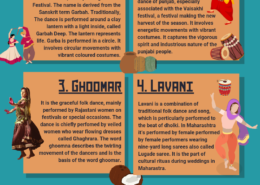Folk dances in India are vibrant expressions of cultural identity and traditions, reflecting the diverse heritage of various communities. Here’s how they serve as a mirror to cultural identity: 1. Cultural Heritage and Traditions Historical Narratives: Many folk dances tell stories rooted in local mRead more
Folk dances in India are vibrant expressions of cultural identity and traditions, reflecting the diverse heritage of various communities. Here’s how they serve as a mirror to cultural identity:
1. Cultural Heritage and Traditions
- Historical Narratives: Many folk dances tell stories rooted in local myths, historical events, or religious traditions, preserving and transmitting cultural narratives from generation to generation.
- Rituals and Festivals: Folk dances are often integral to festivals and rituals, marking important life events such as weddings, harvests, and seasonal celebrations. This connection reinforces community bonds and cultural continuity.
2. Community Identity
- Regional Distinctions: Different states and regions in India have distinct folk dances, such as Bhangra from Punjab, Garba from Gujarat, and Kathakali from Kerala. These dances embody the unique characteristics, customs, and values of their respective communities.
- Social Cohesion: Folk dances foster a sense of belonging and pride among community members, strengthening their identity and cultural unity. Participation in these dances often transcends age, gender, and social status.
3. Expression of Values and Beliefs
- Symbolism: The themes and movements of folk dances often convey the values, beliefs, and aspirations of a community. For example, dances may express gratitude to nature, celebrate agricultural abundance, or honor deities.
- Moral and Ethical Lessons: Many folk dances include elements that impart moral lessons or reflect social norms, teaching community members about right conduct and ethical behavior.
4. Artistic Expression and Creativity
- Local Artistry: Folk dances often showcase the artistic talents of community members through costumes, music, and choreography, reflecting local aesthetics and craftsmanship. Each dance form incorporates distinctive costumes and musical styles, enhancing its cultural significance.
- Innovation and Evolution: While rooted in tradition, folk dances also adapt over time, incorporating contemporary themes or influences. This dynamic nature allows communities to express their evolving identities while maintaining a connection to their heritage.
5. Preservation of Language and Dialects
- Lyrical Components: Many folk dances are accompanied by traditional songs that often feature local dialects and expressions. This preservation of language contributes to the cultural identity of communities and highlights regional linguistic diversity.
6. Intercultural Exchange
- Cultural Interactions: Folk dances often serve as a medium for cultural exchange, showcasing the richness of Indian culture to broader audiences. Events like cultural festivals allow communities to share their dances, fostering mutual respect and understanding among different groups.
Conclusion
In summary, folk dances in India are vital expressions of cultural identity, embodying the history, values, and traditions of specific communities. They not only reinforce social bonds and community pride but also serve as a dynamic medium for preserving and evolving cultural heritage. Through rhythm, movement, and storytelling, folk dances provide insights into the rich tapestry of Indian life, celebrating both diversity and unity.
See less

To promote our old traditional and classical music and dance forms in the modern world, we can embrace a combination of traditional and contemporary approaches. Firstly, organizing cultural events, workshops, and festivals dedicated to showcasing these art forms can raise awareness and appreciationRead more
To promote our old traditional and classical music and dance forms in the modern world, we can embrace a combination of traditional and contemporary approaches. Firstly, organizing cultural events, workshops, and festivals dedicated to showcasing these art forms can raise awareness and appreciation among the younger generation. Utilizing social media platforms and digital marketing to create online content and engage with a wider audience can also help preserve and popularize these traditions.
Collaborating with modern artists to create fusion performances that blend traditional elements with contemporary styles can attract diverse audiences and introduce these art forms to new demographics. Additionally, integrating traditional music and dance programs into educational curricula can ensure the transmission of these cultural treasures to future generations. Supporting local artists, providing funding for cultural institutions, and encouraging community involvement in preserving these traditions are vital steps in safeguarding and promoting our rich heritage of traditional music and dance in today’s fast-paced world.
See less